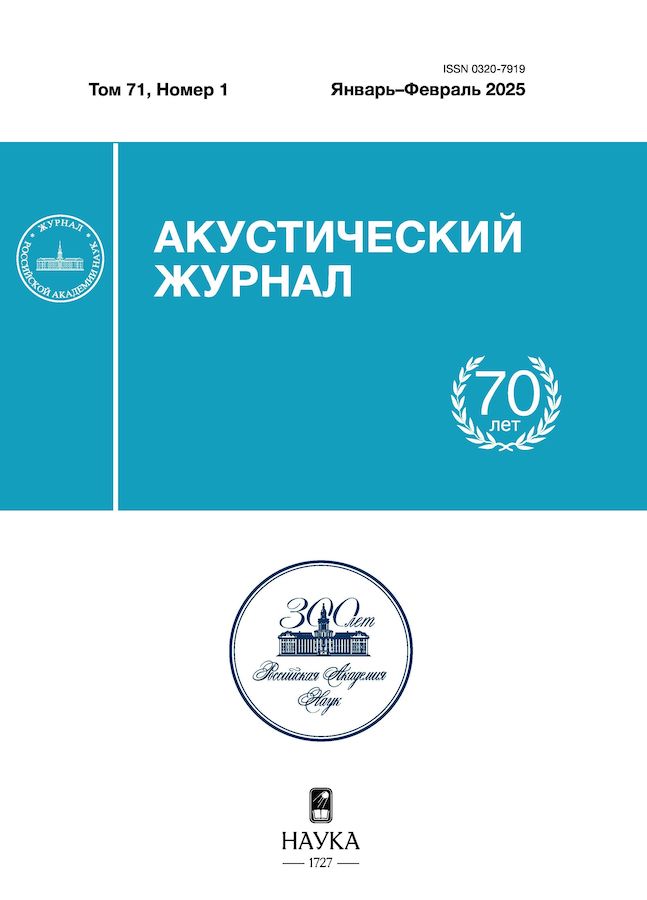Shallow sea reverberation spectra study when the signal transmission and reception points are separated in space
- Authors: Salin B.М.1, Bakhanov V.V.1, Kemarskaya O.N.1, Salin М.B.1
-
Affiliations:
- Federal Research Center A.V. Gaponov-Grekhov Institute of Applied Physics of the Russian Academy of Sciences
- Issue: Vol 71, No 1 (2025)
- Pages: 118-128
- Section: АКУСТИКА ОКЕАНА. ГИДРОАКУСТИКА
- URL: https://ruspoj.com/0320-7919/article/view/683643
- DOI: https://doi.org/10.31857/S0320791925010125
- EDN: https://elibrary.ru/BQDNEB
- ID: 683643
Cite item
Abstract
In this paper we study characteristics of reverberation interference that occurs in the marine environment when long tonal pulses are emmited and scattered signals are recorded using a so-called bistatic scheme, i.e. when the receiver is located at a large distance away from the transducer. Probing of water area with tone pulses is carried out thus the necessary resolution to study both the Doppler spectrum and the temporal development of the reverberation signal is achieved by selecting the proper pulse length. The presented theoretical model is applicable to both direct problem and reverse problems, which are forecasting the characteristics of reverberation for a given sea state, and determining the properties of the marine environment, mainly its near-surface layer, basing on the results of acoustic sounding. The model is based on the representation of a scattered signal in the form of a superposition of reflections from scatterers, which are distributed along the depth and moving along circular trajectories. Their speeds are determined by the maximum amplitude and period of wind waves. The article continues a series of studies and generalizes the previous results to the conditions of significantly separated in space sound sources and receivers. The modeling results are confirmed by experimental data, involving such parameters as the width of the Doppler spectrum and the law of decay of reverberation intensity over time.
Full Text
About the authors
B. М. Salin
Federal Research Center A.V. Gaponov-Grekhov Institute of Applied Physics of the Russian Academy of Sciences
Email: mikesalin@ipfran.ru
Russian Federation, Nizhny Novgorod, 603950
V. V. Bakhanov
Federal Research Center A.V. Gaponov-Grekhov Institute of Applied Physics of the Russian Academy of Sciences
Email: mikesalin@ipfran.ru
Russian Federation, Nizhny Novgorod, 603950
O. N. Kemarskaya
Federal Research Center A.V. Gaponov-Grekhov Institute of Applied Physics of the Russian Academy of Sciences
Email: mikesalin@ipfran.ru
Russian Federation, Nizhny Novgorod, 603950
М. B. Salin
Federal Research Center A.V. Gaponov-Grekhov Institute of Applied Physics of the Russian Academy of Sciences
Author for correspondence.
Email: mikesalin@ipfran.ru
Russian Federation, Nizhny Novgorod, 603950
References
- Луньков А.А. Интерференционная структура низкочастотных реверберационных сигналов в мелком море // Акуст. журн. 2015. Т. 61. № 5. С. 596–604.
- Hartstra I., Colin M., Prior M. Active sonar performance modelling for Doppler-sensitive pulses // Proc. Meetings on Acoustics. 2021. V. 44. Article No. 022001. P. 1–12.
- Ellis D.D. Modeling and Analysis of Target Echo and Clutter in Range-Dependent Bistatic Environments: FY13 Annual Report for ONR // Defence Research Reports, Canada, 2014. Doc. No.: DRDC Atlantic ECR 2013-154. URL: http://cradpdf.drdc-rddc.gc.ca/PDFS/unc155/p539342_A1b.pdf
- Салин Б.М., Кемарская О.Н., Молчанов П.А., Салин М.Б. Исследование механизма уширения спектра низко-частотного реверберационного сигнала при рассеянии звука на приповерхностных неоднородностях в условиях интенсивного ветрового волнения // Акуст. журн. 2017. Т. 63. № 3. С. 314–322.
- Салин Б.М., Салин М.Б. Механизмы формирования спектральных характеристик низкочастотной реверберации и прогнозные оценки // Акуст. журн. 2018. Т. 64. № 2. С. 197–206.
- Салин М.Б., Ермошкин А.В., Разумов Д.Д., Салин Б.М. Модели формирования доплеровского спектра поверхностной реверберации для звуковых волн метрового диапазона // Акуст. журн. 2023. Т. 69. № 5. С. 595–607.
- Андреева И.Б. Сравнительные оценки поверхностного, донного и объемного рассеяния звука в океане // Акуст. журн. 1995. Т. 41. № 5. С. 699–705.
- Акуличев В.А., Буланов В.А. Акустические исследования мелкомасштабных неоднородностей в морской среде. Владивосток: ТОИ ДВО РАН, 2017. С. 182–188.
- Салин М.Б., Потапов О.А., Стуленков А.В., Разумов Д.Д. Исследование распределения реверберационной помехи по частотам Доплера в бистатическом эксперименте в глубоком море // Акуст. журн. 2019. Т. 65. № 1. С. 34–41.
- Ermoshkin A.V., Kosteev D.A., Ponomarenko A.A., Razumov D.A., Salin M.B. Surface Waves Prediction Based on Long-Range Acoustic Backscattering in a Mid-Frequency Range // J. Mar. Sci. Eng. 2022. V. 10. No. 6. Article No. 722. P. 1–18. https://doi.org/10.3390/jmse10060722
- Бурдуковская В.Г., Хилько А.И., Коваленко В.В., Хилько А.А. Анализ влияния длинных поверхностных волн на формирование рассеянного ветровым волнением акустического поля в океанических волноводах // Акуст. журн. 2019. Т. 65. № 6. С. 763–773.
- Андреев М.Ю. Зависимость интенсивности дальней бистатической реверберации от размера базы // Акуст. журн. 1993. Т. 39. № 4. С. 751–754.
- Андреева И.Б., Волкова А.В., Галыбин Н.Н. Обратное рассеяние звука морской поверхностью при малых углах скольжения // Акуст. журн. 1980. Т. 26. № 4. С. 481–487.
- Григорьев В.А., Кузькин В.М., Петников В.Г. Низкочастотная донная реверберация в мелководных районах океана // Акуст. журн. 2004. Т. 50. №1. С. 44–54.
- Janssen P. The interaction of ocean waves and wind. Cambridge University Press, 2004. P. 43-47.
- Ocean-Wave Spectra // WikiWaves [website] URL: https://wikiwaves.org/Ocean-Wave_Spectra , access date: 02-08-2023.
- Лебедев А.В., Салин Б.М. Исследование эффектов локализации областей рассеяния звука на ветровом волнении // Акуст. журн. 2004. Т. 50. № 6. С. 813–826.
- Салин Б.М., Салин М.Б., Spindel R.C. Расчет спектра реверберацонной помехи для доплеровской схемы локации // Акуст. журн. 2012. Т.58. № 2. С. 258–266.
- Jenserud T., Ivansson S. Measurements and Modeling of Effects of Out-of-Plane Reverberation on the Power Delay Profile for Underwater Acoustic Channels // IEEE J. Oceanic Engineering. 2015. V. 40. No. 4. P. 807–821.
- Григорьев В.А., Луньков А.А., Петников В.Г. Затухание звука в мелководных акваториях с газонасыщенным дном // Акуст. журн. 2015. Т. 61. №1. С. 90–100.
- Шулейкин В.В. Физика моря. М.: Наука, 1968. 1090 с.
- Пери А.Х., Уокер Дж.М. Система океан-атмосфера. Л.: Гидрометеоиздат, 1979.
- Абузяров З.К. Морское волнение и его прогнозирование. Л.: Гидрометеоиздат, 1981. 166 с.
Supplementary files
















